
Mastering Business Lead Generation: Strategies for 2025 Success
Master business lead generation for 2025 success. Discover strategies, digital channels, and optimization tactics for quality leads.
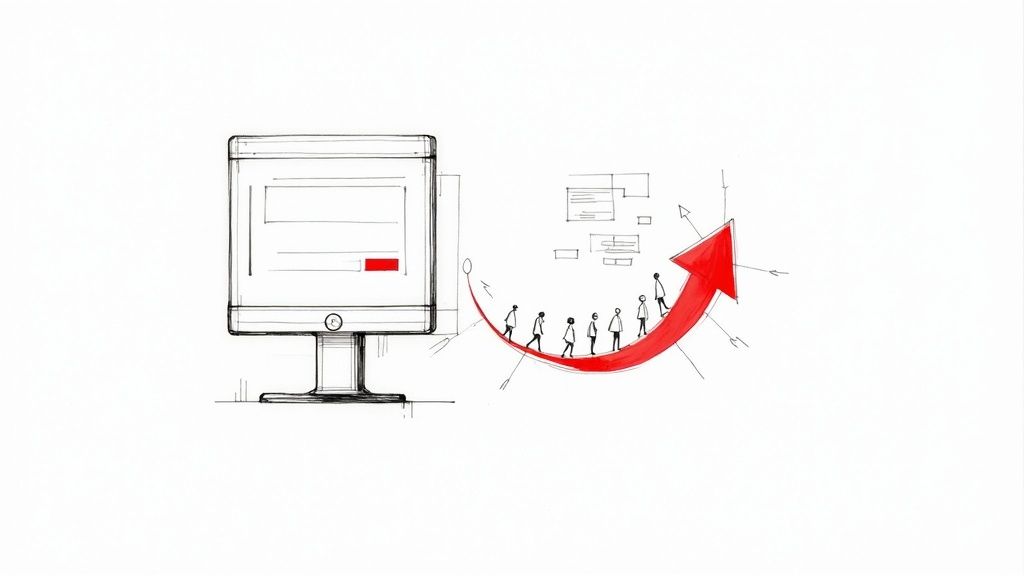
To get more conversions from your website, the first step isn’t to change anything. It's to figure out what a "conversion" actually means for your business and set clear benchmarks for success.
This means looking beyond just the final sale. Think about all the valuable actions a visitor can take, like signing up for your newsletter or requesting a demo. Real growth comes from understanding your users and removing the frustrations that get in their way, not just from making random tweaks and hoping for the best.
Before you think about touching a button color or rewriting a headline, you have to define what a win looks like. A "conversion" is a flexible term—it’s simply any valuable action a visitor takes on your site.
For an e-commerce store, the big one is obviously a purchase. But for a B2B company, a conversion might be a filled-out contact form or a downloaded case study. Getting this distinction right is the bedrock of any solid optimization plan. Without clear goals, you’re flying blind.
It helps to know the lay of the land. Historically, the average e-commerce conversion rate hovers between 2.5% and 3%. You'll see more established brands hitting that 2.5% to 4% range, while newer stores might be closer to 2-2.5%.
But remember, industry averages are just a guidepost. Your most important benchmark is your own performance, tracked over time. The only way to see real improvement is to consistently watch your numbers. This kind of deep data dive is a core practice for any good data-driven marketing agency.
The goal isn't just to get more clicks; it's to guide the right visitors toward the actions that grow your business. Focusing on user intent is more powerful than chasing vanity metrics.
Here's a quick look at the key metrics you should be keeping an eye on.
This table breaks down the essential metrics for understanding and improving your website's performance.
Tracking these numbers gives you a clear, data-backed picture of what's working and what isn't.
Ultimately, your conversion strategy should be about understanding what your users truly need. Once you have these fundamentals down, you can find other resources covering the top strategies to improve website conversion rates to keep pushing your performance forward. Every change should solve a problem for your customer, making their path from visitor to customer feel effortless.
Nothing kills a potential sale faster than a confusing website. If you want people to convert, your number one job is to create a smooth, intuitive path that guides them right where you want them to go. Think of it like a clear, well-lit hallway—every element should serve a purpose in getting them to their destination.
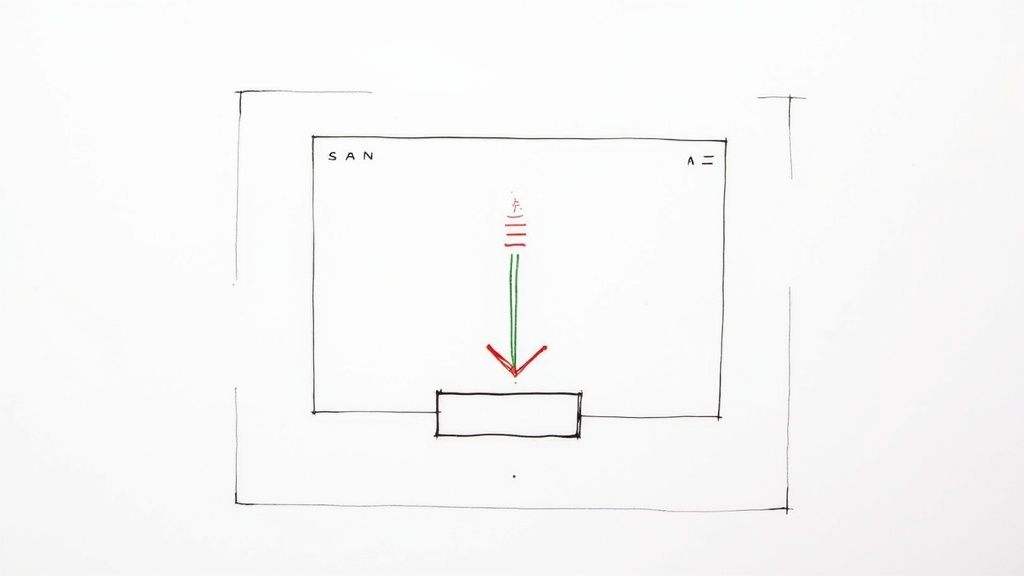
It all starts with your site’s navigation. If someone can't find what they need in a couple of clicks, they're gone. And they probably won't be back—a staggering 88% of online consumers say they're less likely to return after a bad experience. This makes getting the user experience (UX) right from the start non-negotiable.
Visual clutter is the arch-nemesis of conversions. Every extra image, chunky block of text, or flashy animation is just one more thing pulling your visitor's attention away from the real goal. To get more conversions, you have to be ruthless. Cut anything that doesn't directly help the user on their journey.
For every element on your most important pages, ask yourself these tough questions:
If the answer is "no," it's probably hurting you. A clean, focused interface naturally draws the eye to your calls-to-action. For example, creating effective local SEO landing pages means stripping away the noise and delivering a focused message that speaks directly to local customers.
A great user experience isn't about piling on more features; it’s about strategically removing friction. The easier you make it for someone to accomplish their goal, the more likely they are to do it.
At the end of the day, it's all about getting inside your user's head. Think about their mindset at each stage and give them exactly what they're looking for, whether that's clear product info, trust signals like reviews, or a big, obvious button to click next.
In a world where attention spans are measured in seconds, your website's speed is everything. It's not just a technical metric; it's the first impression you make. A slow, clunky site feels frustrating and untrustworthy, sending potential customers clicking away before they even see what you offer.
Every single second counts.
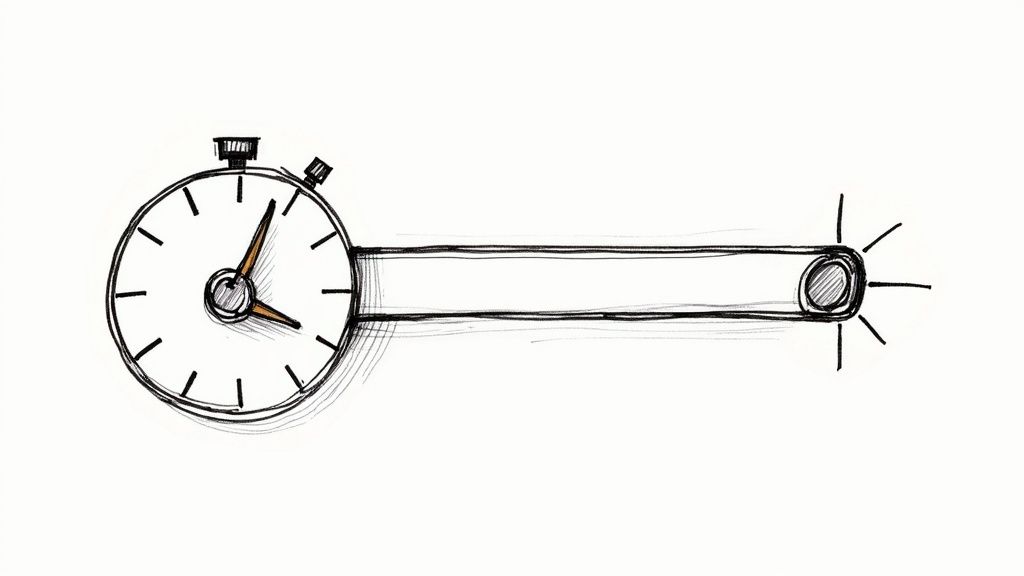
The data is crystal clear. The connection between how fast your site loads and how many visitors convert is undeniable. For example, a site that loads in a blistering one second can see its conversion rates triple compared to a site that takes a sluggish five seconds.
Compare that to a ten-second load time, and you could see a fivefold increase in conversions. You can dig into more of this data in these conversion rate statistics from Wordstream.
Boosting your site speed doesn’t always mean a full technical overhaul. You'd be surprised how much difference a few straightforward tweaks can make. The goal is simple: reduce the amount of stuff a visitor's browser has to download.
Here are a few high-impact techniques:
Shaving even half a second off your load time can lead to a measurable lift in conversions. Speed is a direct reflection of your site’s quality and respect for the user's time.
The platform your website is built on—your content management system (CMS)—also plays a huge part in its performance. For a deeper look at how your choice of platform impacts speed and search rankings, check out our guide on the relationship between SEO and your CMS. A faster site creates a seamless, enjoyable experience that keeps people engaged.
Your call-to-action (CTA) is arguably the most important button on your website. So why do so many businesses treat it like an afterthought? If you're still using a generic "Submit" or "Click Here," you're leaving conversions on the table.
An effective CTA does more than just ask for a click; it inspires action. The trick is to swap dull, generic verbs for strong, benefit-driven language. For instance, instead of "Download," try "Get My Free Ebook." That small tweak shifts the focus from what the user has to do, to what they’re about to get. It instantly answers the question: "What's in it for me?"
You'd be surprised how much color and placement can influence a user's decision. While there's no single magic color that converts best for everyone, the one rule that always holds true is contrast. Your CTA button needs to visually jump off the page, demanding attention.
If your site's color scheme is mostly blue and white, a bright orange or vibrant green button will naturally draw the eye far more effectively. It's about making the desired action the most obvious thing on the screen.
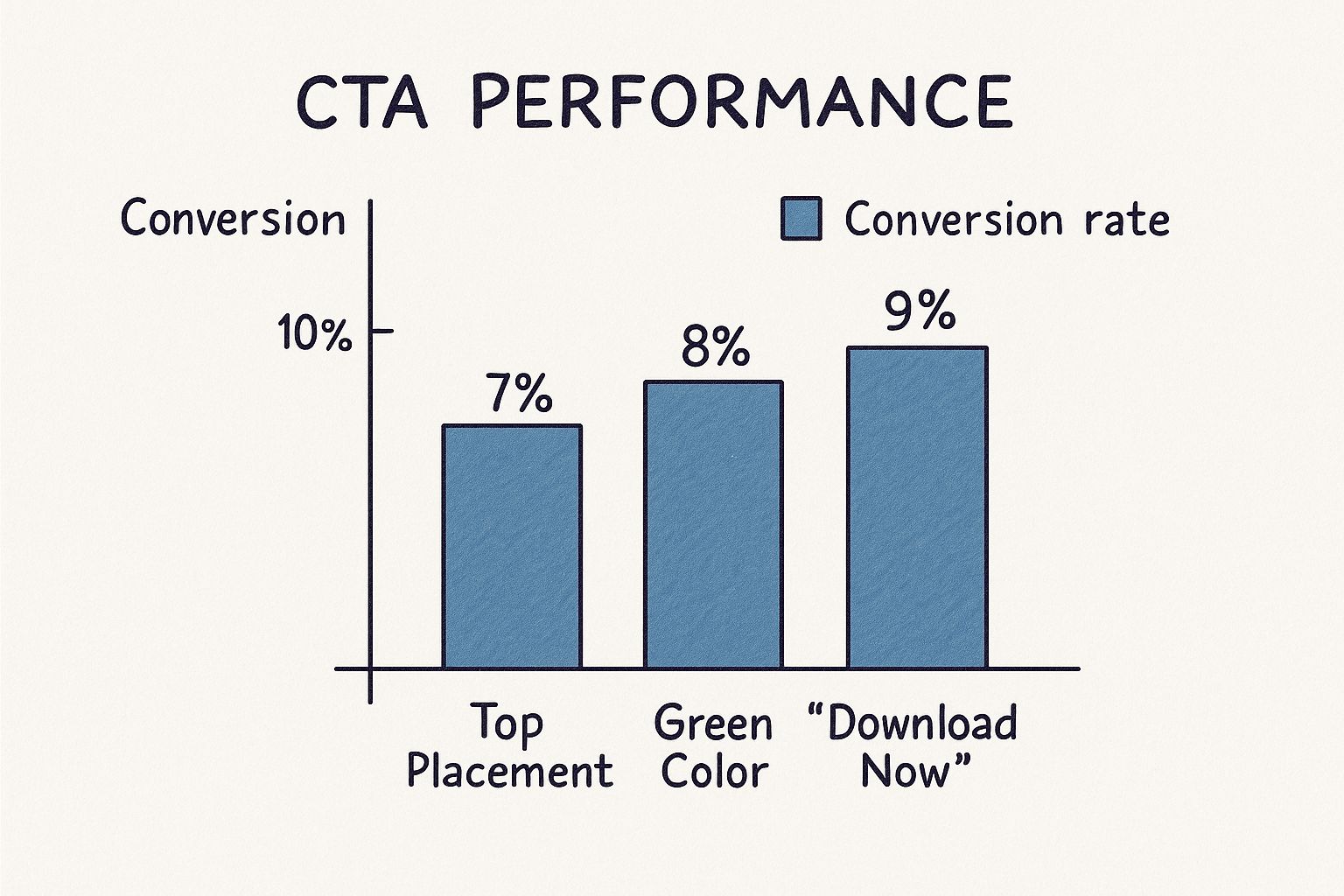
As you can see, minor adjustments to your CTA's wording, color, or location can produce significant gains. Another powerful technique is to use human psychology. Phrases that tap into urgency, scarcity, or social proof can give users the final nudge they need.
Here are a few effective examples:
I've always found that the best CTAs are a perfect blend of art and science. They mix compelling copy and standout design with a real understanding of what motivates the user, making that click feel like the most natural next step.
Ultimately, you won't know the perfect CTA for your audience until you test it. Don't be afraid to run simple A/B tests on button text, colors, and placements. The data will show you what resonates with your visitors.
Not every visitor to your site is created equal. Some are just window shopping, clicking around with no real intent. Others, however, land on your page ready to take action. To move the needle on conversions, you have to figure out where your most valuable, high-intent traffic is coming from.
Then, you double down on what's working.
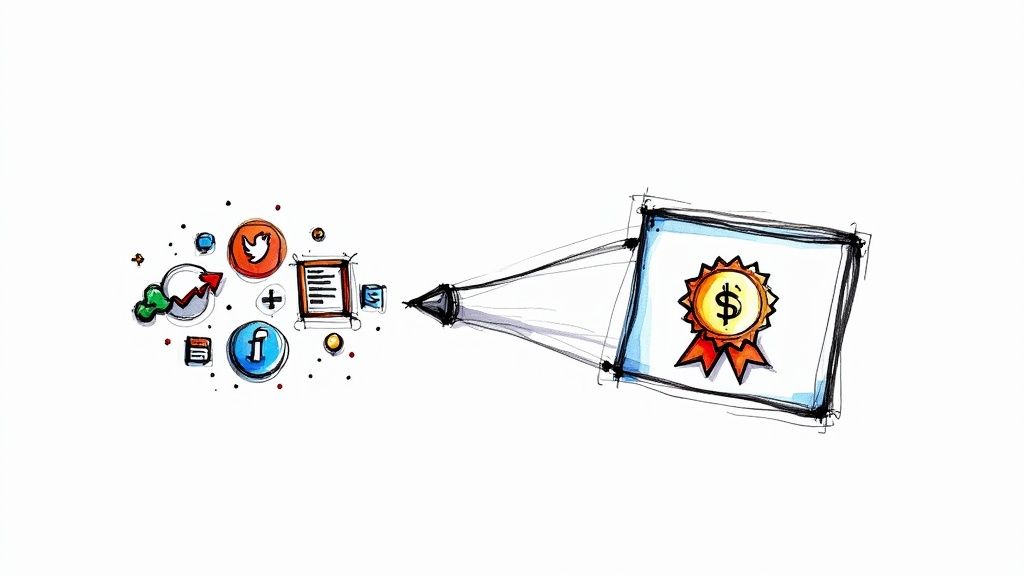
This isn’t about chasing vanity metrics like raw clicks. It’s about attracting the right kind of visitor—the one who is actually going to convert. By digging into your traffic sources, you can see a clear pattern of which channels deliver people primed to take action.
Different marketing channels pull in people at different stages of their buying journey, and you can see this play out in the numbers.
For example, direct traffic (people typing your URL into their browser) often boasts the highest conversion rate at around 3.3%. Why? Because these visitors already know and trust your brand. They're returning with a purpose.
Organic search is another heavy hitter, bringing in high-quality leads that convert at a solid 2.3%. Meanwhile, paid channels like social media ads and PPC tend to have lower rates, hovering around 1.5% and 1.6%. You can check out some helpful conversion rate benchmarks on First Page Sage.
To get a clear picture of your best performers, you need to get your hands dirty in your analytics. Start by asking a few critical questions:
Answering these questions is the first step to understanding where your marketing budget is truly making an impact. It's also the foundational data you need when you start figuring out how to calculate marketing ROI, allowing you to make decisions backed by hard evidence, not gut feelings.
The table below gives a snapshot of what to expect from different channels.
As you can see, the channels with the highest intent (Direct, Organic) typically outperform those focused on discovery (Social). Use this as a guide to prioritize where you spend your time and money.
Your best traffic source isn’t necessarily the one that sends the most visitors—it's the one that delivers the most profitable customers. Focus your energy and budget there for the biggest impact.
By systematically identifying and prioritizing your top-performing channels, you can stop wasting money on sources that don't deliver. Instead, you can reinvest in the ones that do, giving your conversion rate a serious boost.
Diving into conversion optimization often brings up the same set of questions. Let's break down some of the most common ones with practical, no-nonsense answers to help you move forward with confidence.
This is a big one. It's tempting to call a test the moment you see one version pulling ahead, but that's a classic mistake. You've got to let it run long enough to hit statistical significance.
This means the results you're seeing are real and not just a fluke. In my experience, this usually takes at least two to four weeks. This window gives you enough time to smooth out daily and weekly traffic swings—think weekend shoppers versus weekday researchers.
If you cut it short, you risk making a major business decision based on bad data. That can unravel all your hard work in a hurry.
Patience is everything in testing. The real win isn't just finding a "better" button color; it's about gaining genuine insight into what actually makes your audience tick.
Everyone wants to know the magic number, but the truth is, it doesn't exist. You'll often see an average floating around of 2% to 5%, but a "good" rate is completely relative to your world.
It all depends on your industry, traffic quality, and price point. A B2B company selling six-figure software might be thrilled with a 1% conversion rate. An e-commerce store selling t-shirts might be shooting for 4% or more.
Instead of getting hung up on a universal benchmark, focus on these two things:
Getting this right is crucial for understanding the entire customer journey, not just the final sale.
A macro-conversion is your primary goal. It's the finish line—the one big action you want someone to take.
Micro-conversions are the smaller, incremental steps people take on their way to that macro goal. They're signals of interest and engagement.
By tracking and improving these smaller wins, you're essentially paving a smoother road to the final destination. Each micro-conversion is a chance to build trust and move the user one step closer to the ultimate goal.
Ready to turn more visitors into customers with a data-backed strategy? BrandBooster.ai combines expert insights with advanced AI to deliver marketing solutions that produce real results. Let us help you build a high-performing marketing plan that fuels sustainable growth. Learn more and see what we can do for you.